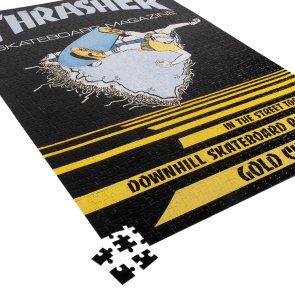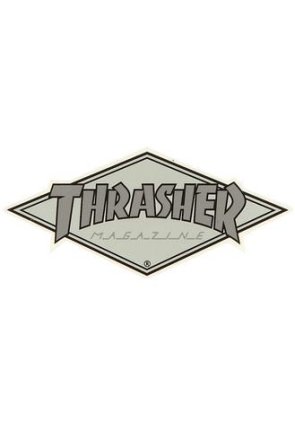
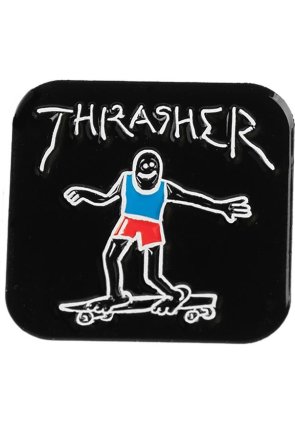
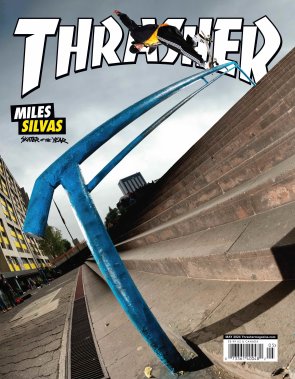



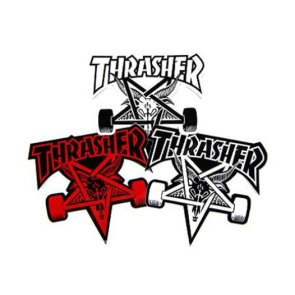


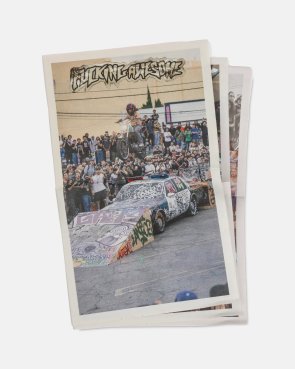
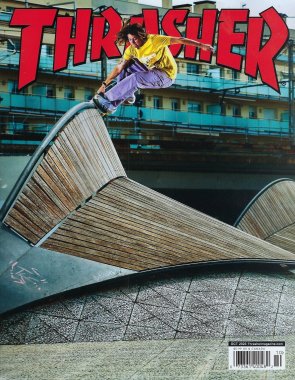
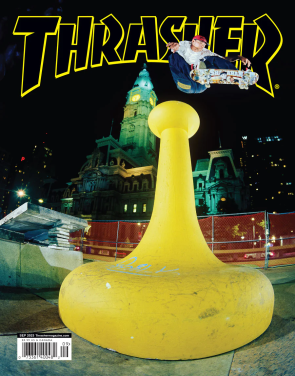
Thrasher Magazine
Published monthly in San Francisco, California since January 1981, Thrasher is the longest-running and best-selling skateboard magazine of all time. Its name is synonymous with the roots and constant evolution of skateboarding, and its staff strives to define that evolution and the adventurous spirit of its readership.
Say "1981" out loud. It may not sound like "1969" or "Y2K," but that second year of the 1980s was a historic first: That spring, NASA launched the first reusable space shuttle, Columbia. IBM introduced the first personal computer. That summer, MTV was broadcast for the first time. But at the beginning of the year, before all these other events, a group of skateboarders in a corner of San Francisco put together the first issue of Thrasher magazine.

Thrasher quickly became the most respected skate magazine in the world; skateboarding had found a mouthpiece and made its mark on the landscape. What began as a 32-page tabloid evolved into several respected brands - including Juxtapoz and SLAP magazines - as well as a series of books, ramp building guides, skate rock albums, Thrasher videos and DVDs, a hugely popular product and softgoods line, and the number one online authority on skateboarding.
Today, Thrasher is bigger and better than ever before. Its name is synonymous with the roots of skateboarding and its constant evolution, and its staff is dedicated to defining that evolution and the adventurous spirit of its readership. Major international corporations try to convince themselves of our credibility, while kids tattoo the magazine's mantra, "Skate And Destroy", onto their skin. Like those tattoos carved into the arms of skaters around the world, Thrasher is forever.
Thrasher is more than just a skateboarding magazine. It's an iconic publication that chronicles the evolution of street culture from a skater's perspective. In the world of skateboarding, there have been several relevant skateboarding magazines, but few have stood the test of time. Thrasher was founded in 1981 by Eric Swenson and Fausto Vitello in San Francisco, California. Eric Leon Swenson was born in San Francisco on August 4, 1946. He was a fan of punk music and hard rock and loved to play guitar and repair motorcycles. His future business partner, Fausto Vitello, was born three days later, on August 7, 1946, in Buenos Aires, Argentina. Vitello's family moved to California during the Liberation Revolution (Revolución Libertadora) that took place in their home country. The duo met in the US Army Reserve in the 1960s, and their shared passion for motorcycles developed into a unique friendship. In 1978, Swenson and Vitello teamed up with Richard Novak and Jay Shuirman to form the Independent Truck Company. Three years later, in January 1981, the friends launched Thrasher Skateboard Magazine, a publication that would serve as an advertising medium for their skate truck company.
Thrasher was an alternative skateboarding magazine published by High Speed Productions. The famous Thrasher logo uses the Banco font designed by Roger Excoffon in 1951. The magazine's motto - "Skate and Destroy" - was an expression of the skaters and punks of the 1970s. Although it was not the best-selling title within the sport for a long time, it evolved as a raw underground response to those who promoted skating as a polished mainstream outdoor activity. In some ways, the essence of Thrasher mirrored the personalities of its founders. While the Californian was a low-key thinker, the Argentinian was outspoken, exotic and loud. The first editor of Thrasher was Kevin Thatcher. Mörizen "MoFo" Föche, the legendary skate photographer, was the magazine's second contributor. A look at the covers of Thrasher magazine shows the evolution of skateboarding as a sport and as a socio-cultural manifestation of street culture. "The very first cover of Thrasher was an illustration of a skater dribbling over coping in a pool, but the other 11 covers of the first year showed examples of what was fading in the past, what would come in the future, but most importantly, what was happening now and what was happening was vert skating in the 'Three P's': pools, parks, and pipes," notes Ben Marcus, author of "The Skateboard - The Good, the Rad, and the Gnarly: An Illustrated History."

"The first year of Thrasher, downhill racing was on the cover one and a half times, but that might have to do with the fact that the magazine was founded by a company that had first made a name for itself in downhill and slalom skateboarding at La Costa, Signal Hill, the Catalina Classic and the Capitola Classic." "The rest of the 1981 Thrasher covers centered around Vert and the Vert heroes who were just coming up. Chris Strople's frontside slash in a pool, Chris Miller's organic frontside foot plant halfpipe, Allen Losi's fakie foot plant ollie in a skatepark bowl, Duane Peters doing an agro sweeper recovery, and many others." One of Thrasher's most popular features is the "Hall of Meat," a photo spot reserved for nasty and disgusting injuries submitted by readers.
The Jake Phelps era
In 1993, a new man took the helm - James Kendall Phelps, a personality who would become the face and soul of Thrasher. Jake Phelps had met Swenson and Vitello at Concrete Jungle in 1986. The duo initially invited him to work as a writer for the magazine, but three years later Phelps was already Thrasher's mailroom manager. After taking over as editor-in-chief in 1993, the controversial skater with the punk attitude grew the magazine like never before. Jake Phelps loved skateboarding. It was his life. But he also fell in love with the magazine, even though he could be aggressive, problematic, unfair and caustic at times. His rough skateboarding attitude translated into an alternative lifestyle and a 290-page medical record that included seven knee surgeries and fractures to his legs, pelvis, collarbones, thumb and skull. "Jake didn't even have a computer on his desk. He didn't have an e-mail address, and his answering machine wasn't even set up," a Thrasher employee once revealed.
Phelps led Thrasher for 27 years. He passed away on March 14, 2019 at his home in San Francisco at the age of 56. The cause of death was not made public. Jake was cremated along with his skateboard, and his name was spray-painted in his honor at Potrero del Sol Skatepark. The truth is that both Swenson and Vitello did not outlive the iconic editor-in-chief of Thrasher. Fausto Vitello died of a heart attack while riding his motorcycle in 2006, and his son Tony took over the magazine. On June 20, 2011, Eric Swenson ended his life at the age of 63 in front of a police station in San Francisco. The Californian had been in severe pain for a long time following a motorcycle accident that led to multiple joint problems. He shot himself in a public place so that his family could easily find his body.

More than just a skateboard magazine
After the first few years were over, it was clear that Thrasher would become more than just a skateboard magazine. In fact, it became a brand with multiple business interests. In 1999, the magazine sponsored the Playstation video game "Thrasher Presents Skate and Destroy". The title ended up competing directly with "Tony Hawk's Pro Skater". Thrasher's game adventure had more realistic gameplay, broken boards, broken bones and even police custody. The goal was to find a sponsor and get on the cover of Thrasher. However, due to mixed reviews and a record-breaking opponent, sales never really took off and the game was not continued.
Today, Thrasher is one of the most popular skateboard brands in the world and benefits from its reputation and credibility. The brand sells T-shirts, balaclavas, hoodies, hats, jackets, shorts for girls, bandanas, socks, bags, stickers, necklaces, key rings, sunglasses, pins and patches, belts, skate bags, beach towels and much more. The biggest and most influential skateboard magazine of all time has also been presenting the Skater Of The Year (SOTY) Award without interruption since 1990. It is the most prestigious trophy in skateboard culture. From 1983 to 1990, Thrasher released "Skate Rock", a music compilation series featuring thrash and punk rock bands made up of skaters. The albums were sold as cassettes and vinyl records.
In 2003, Thrasher launched "King of the Road", a skateboarding competition series that takes place in the United States and China (2011 only) and was designed by Micheal Burnett. The event invites groups of skateboarders who are given a list of challenges. Each team has two weeks to complete all the challenges, with points awarded later for performance. Thrasher also operates its own indoor skatepark. Double Rock is located somewhere on the San Francisco Bay and is accessible by invitation only for special shoots. 66 6th St is a museum store where skateboarders and the public can explore the history of skateboarding and also buy Thrasher branded clothing.








